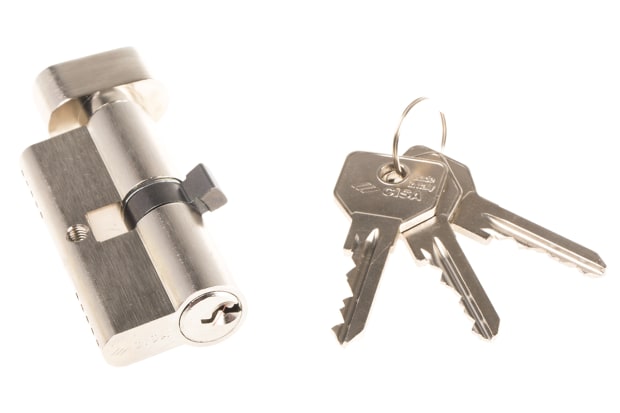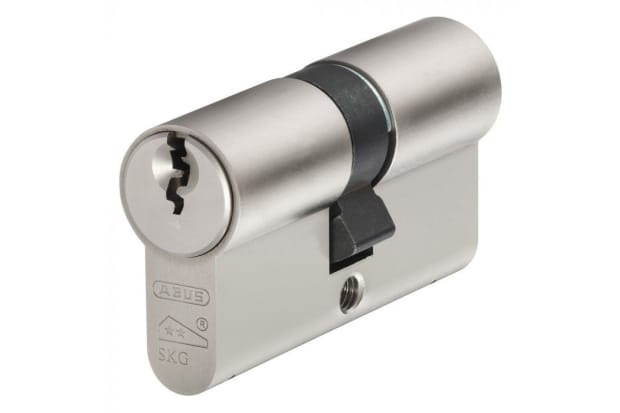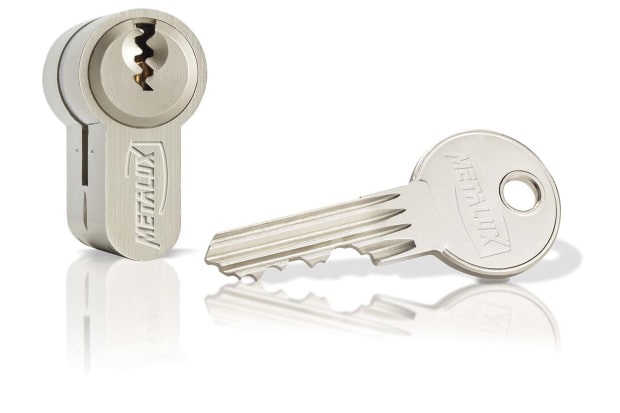- Published 17 Jan 2023
- Last Modified 29 Aug 2023
- 9 min
A Complete Guide to Euro Cylinder Locks
Our euro cylinder locks guide explains what they are, where they can be used, how they work, and how to fit them.

Reviewed by David Carmichael, Solution Engineer (November 2021)
What is a Euro Cylinder Lock?
So, just what is a euro cylinder lock? Euro cylinder locks are one of the most widely used door lock types in the UK.
These devices are a form of pin tumbler, meaning that they contain pins of varying lengths which press against the serrated edges of the inserted key in order to detect the correct pattern for unlocking.
Pin tumbler locks frequently feature a cylinder design and euro is a particular profile (cross-sectional design) of cylinder lock. The cylindrical barrel is easy to repair and replacements allow you to change the compatible key and increase security. To do so, simply loosen a screw, slide out the cylinder, and replace it with one of the same size.
Some euro locks feature five pins and others six. The latter costs a little more but provide an additional level of security.
Euro cylinders locks are also known as euro lock barrels.
What Doors are Euro Cylinders Suitable for?

Euro profile cylinder door locks feature a versatile design compatible with a wide range of door types and keys. Common uses include:
- uPVC door cylinder locks
- Aluminium door euro locks
- Garage door euro cylinder locks
- Cylinder locks for storage units
- Patio door cylinder locks
- French door euro locks
- Wooden door cylinder locks
- Steel door euro locks
Euro cylinder door locks can be used on both internal and external doors. Six pin locks are recommended for the latter because they are harder to force.
Cylinder locks also make a good choice for internal doors in office buildings or factories where certain spaces need to be secured, for example. In such instances, an inexpensive five-pin model will most likely suffice.
Types of Euro Cylinder Lock
Just like other models, euro cylinder locks are available in a number of different types. Here are some of the principal ones:
Half Euro Cylinder
Half euro cylinders are a shorter model. They are designed for locations where key access is required from one direction only - for example, garage doors. They are also known as single euro cylinders.
Double Euro Cylinder
Double euro cylinders are so-called because they feature keys at both ends, so they can be locked and unlocked from either side. This provides a greater level of security.
Nowadays, double euro cylinders are principally used on uPVC doors. These models are also known as full euro cylinders.
Thumb-Turn Euro Cylinder Locks
Thumb turn locks require only thumb pressure to release them, allowing speedier operation than conventional locks in emergency situations.
Thumb-turn euro cylinders are available in two varieties. These are full models, which combine a keypad on one side and with a key lock on the other, and half models, which feature a keypad only.
Anti-Snap Euro Cylinder
Euro cylinder anti-snap locks are a reinforced model designed to resist lock snapping - a burglary technique in which a tool is used to apply force to a lock in order to break it open. The technique exploits a weak spot at the centre in some models of cylinder lock. Determined burglars sometimes go to the extreme of applying a blowtorch to the surrounding door in order to expose the lock.
Anti-snap euro cylinder locks feature an incision, called a sacrificial snap line, along their outer casing. If a burglar applies force, this snap line will break but the central locking mechanism will remain intact. This design is available from major lock brands like Yale.
High-Security Euro Cylinder Locks
In addition to anti-snap models, other high-security euro-cylinder lock designs include:
Anti-Pick Locks
These are designed to withstand lock picking (manipulation of the internal pins with tension tools to align the mechanism and open the lock). Anti-pick locks make this much more difficult with pins that resist manipulation.
Anti-Drill Locks
Anti-drill locks are made from specially hardened steel to prevent brute force assaults with drilling equipment.
Anti-Bump Locks
Bumping is another technique used by criminals intent on breaking and entering. A modified key is forced into a cylinder lock and then torque is applied to try and push it open. If successful, this technique may not leave visible damage and that could adversely affect insurance claims. Anti-bump locks feature pins set at different levels which can only be accessed with special key grooves, to prevent the internal cylinder from rotating when pressure is applied.
How Does a Euro Cylinder Lock Work?

Let’s look at how a euro cylinder lock actually works. They contain a matching set of either five or six pins. The upper plugs are the same length, flat at both ends and attached to springs. Meanwhile, the lower plugs are uneven in length and are tapered at each end.
The unique pattern of indents along the key blade match the varying lengths of the lower pins so that when the key is inserted these will be pushed up to lie flat against the upper pins. This allows the cam (projecting part) to push or pull the internal bolt, thereby opening or closing the door. However, this will not occur if the wrong key is inserted because the lower pins will not match the indent pattern.
The extra pin in six-pin locks makes these harder to pick or force, so these are a more secure choice.
How Secure are Euro Cylinder Locks?
Euro cylinder locks are reliable and secure if they come from a reputable manufacturer. It is also important to pay due regard to the location of the door and the level of security you will therefore need. For example, security experts recommend a six-pin lock for all exterior doors.
How to Fit a Euro Cylinder Lock
Here is how to change a euro lock cylinder if you wish to swap the keys or fit a newer lock model in your door:
- Open the door and locate the screw on the edge of the door, near the bottom of the lock barrel. It should line up approximately with the latter
- Undo this using a Phillips screwdriver. If the screw is stubborn and will not turn, apply oil and leave for a little while before making a fresh attempt. If the screw is damaged or broken, use a chisel to work it loose, turning in the same direction you would unscrew
- Insert the key from the inside direction. Move this back and forth and pull backwards. This should dislodge the barrel. If you encounter resistance, the lock may be slightly misaligned, so apply patience and persist
- Slide the barrel out
- Fitting the new or replacement barrel requires a simple reversal of the above process
How to Measure a Cylinder Lock
If you are planning to install a euro cylinder lock, it is important to ensure that you have the correct measurement template. To obtain this, you will need to measure the width of your door, including any escutcheons (protruding embellishments) and handles. The lock will, of course, be embedded in the latter.
Here is how to measure a euro cylinder lock:
- Measure the door from the outer edge of the escutcheons or handles to the centre. You now have the external size to centre measurement
- Measure from the inner edge - again including handles and any escutcheons - to the centre of the door. This is the internal size to centre
- Double-check these figures by measuring the full length of the door, from the inside edge to the outside edge. This should be the sum of the first two figures
You now know the length of the cylinder lock required.
How to Drill a Euro Cylinder Lock
Lock drilling is a last resort option if you have lost the key to a property or need to gain entry in an emergency. However, if in doubt, locksmiths are a reliable option. Here is how to drill out a euro cylinder lock yourself, in just a few minutes:
- Prepare your drill - a 4.8mm (3/16th of an inch) drill bit would be a good choice. These have a diameter of approximately 6.4mm (¼ of an inch)
- Cover the lock with a length of masking tape to catch metal shavings during the drilling and press this down to reveal the central circular area
- Drill approximately 19mm (¾ of an inch) into the lock, endeavouring to keep the drill bit level while doing so
- When the drill bit hits the inner latch, the lock will pop open
- Clean up and when ready, arrange a replacement for your euro cylinder lock
Euro Cylinder Lock Sizes

Euro cylinder locks are available in a variety of sizes to suit different doors. The length of lock you need will depend on the thickness of the door, so begin by measuring that.
Typically, full-size euro lock sizes range between 60mm and 120mm, with the central cam located precisely halfway along the barrel. Meanwhile, half euro cylinders are on average between 40 and 50mm in length. These lengths may be listed as a whole number or as two halves - e.g. a 40 x 40mm euro lock will be 80mm in length.
uPVC doors are an exception. Thanks to the typical dimensions of such doors, compatible locks - normally 70mm to 120mm - usually have uneven lock cylinder sizes: for example, an 85mm uPVC euro lock might be 45mm on one side and 40mm on the other.
Euro Profile Cylinder Dimensions
The central cylinder of a euro lock can be changed relatively quickly to fit a new set of keys. However, to do so, you will need to know the dimensions of the existing euro profile cylinder. This can be measured either while the lock is still in situ within the door or after removal.
To do so while the lock is still in place, measure from the centre of the retaining screw to the inner and outer sides of the bottom of the handle backplate (the plate on the outer edge of the door). Round the results up to the nearest 5mm.
To measure the cylinder barrel once the lock has been removed from the door, measure from each end to the central screw, including the central cam ring in your measurement.
Other Types of Cylinder Lock
Euro cylinder locks are not the only models available. Other types of cylinder lock include:
Oval Cylinder Locks
Oval cylinder locks work in a similar way to the euro cylinder but have an oval-shaped barrel.
Mortice Locks
Mortice locks have a larger housing than euro cylinders and are threaded, which makes them highly resistant to being forced. Thanks to their size, they are compatible with a smaller range of doors. However, they are typically more expensive.
KIK Cylinders
Key-in-Knob or KIK cylinders are highly flexible and can be used with a variety of locking mechanisms. They are most effective when installed within a doorknob or door handle - otherwise, they are vulnerable to breakage.
Interchangeable Core Cylinders
These feature a fully removable and replaceable central mechanism, which makes them easy to change quickly in the event of a break-in or when it is necessary to exclude someone with an existing key. They are more expensive than other types of cylinder lock.
What is the Best Euro Cylinder Lock for Your Door?
What are the best euro cylinder locks in the UK? This depends on three key factors:
- The type of door you wish to secure - e.g. the backplate on uPVC doors is not symmetrical so you will need the correct size of cylinder lock
- The location of the door - e.g. internal or external
- The level of security required - do you need a more expensive but also more secure six-pin model for maximum security, or will a five-pin model suffice?

